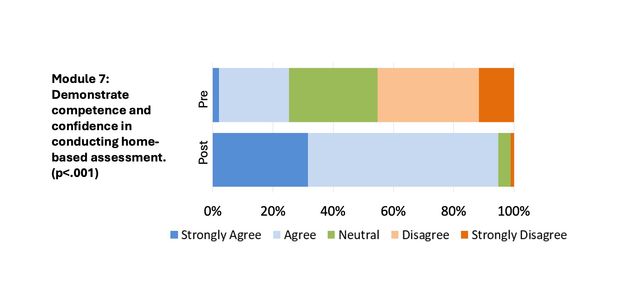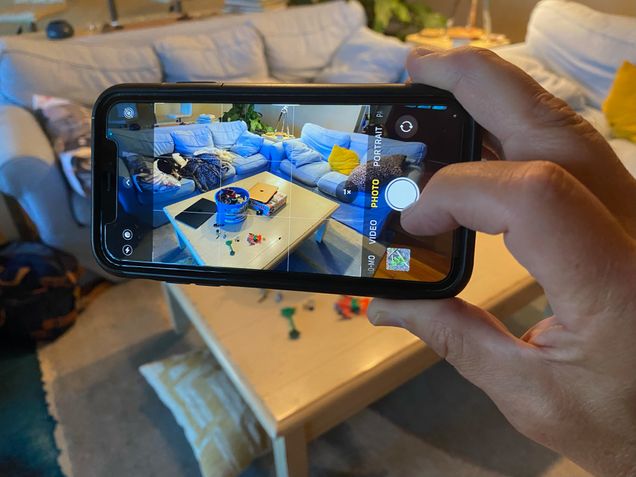This interprofessional project is a collaboration between the BU School of Social Work (SSW) and Sargent College of Health and Rehabilitation Sciences (Sargent) to create online interactive simulations of home environments that prepare graduate students across health professions to conduct home assessments.
Project Impetus
Home visits are a key aspect of the role of many health and social service professionals. Yet, students do not receive hands-on, interprofessional learning to prepare them for home-based assessments during practicums and/or after graduation. Often, this training is left to community agencies, leading to varied depth, standards, and quality. This project improves the students’ experience and increases students’ confidence in conducting home-based assessments as they transition to their post-grad careers.
Our goal is to create simulated home environments to prepare students to conduct home assessments for people with disabilities and older adults.
Pedagogical Strategies
To address these concerns, the project team developed six overarching goals for this project:
- Use technology for project-based and experiential learning and create simulated home environments to prepare students to conduct home assessments for people with disabilities and older adults
- Connect classroom learning to real-life skills
- Increase learners’ skills and confidence and consumer outcomes
- Improve student performance in practicum experiences
- Evaluate simulations for realistic and detailed reenactments of various home visit scenarios
- Integrate training at each participating school and beyond with a focus towards scalability and sustainability of effective interprofessional training
To accomplish these goals, the project team partnered with Jackrabbit LX to develop interactive training simulations using artificial intelligence (AI). The training features six asynchronous online modules in Blackboard Ultra and an interactive synchronous experience to promote interprofessional collaboration. The modules include features and tools such as Synthesia, chatbots, 3D interactives, H5P hotspots, and 360 images.
Project Impact
In the first year of the project, the team trained 14 students in Social Work and 19 students from Sargent College. In the second year, the team trained 45 students in Social Work, 38 from Sargent College, 7 from the Medical School, and 6 from the Physician Assistant Program.

Through pre-/post-test assessments, the team found that knowledge and skills improved in: assessment, team-based care, communicating with person and family, cultural considerations, reliable and valid assessment tools, ethical and legal practices, and confidence in home-based assessments. The students expressed overall satisfaction in completing the modules and increased interprofessional collaborations.

I will be more confident in my abilities to do home assessments and comfortable knowing that there are other professionals that I can work with to help my clients work toward their personal goals.
Looking Forward: Next Steps
For the final year of this pilot project, larger scale piloting is planned with students in Social Work, Speech, Language & Hearing Sciences, Occupational Therapy, Physical Therapy, Nutrition, the Medical School, and the Physician Assistant Program, which will continue to expand interprofessional collaboration. The project team also plans to expand the reach of this training to community agencies and services for staff development.

With an eye towards project sustainability, the online modules will be embedded in Sargent’s Interprofessional Education (IPE) and SSW Field Readiness curricula and housed through The Network for Professional Education (a previous Shipley Center-funded project). The project team is also exploring opportunities to commercialize the modules to agencies/schools/institutions to expand the reach of this innovative model outside of BU.
Conferences, News & Publications
- Muroff, J., Keefe, B. Slater, C., Jacobs, K., & Nizza, M. (2026). Assessing the Effectiveness of an Innovative Interprofessional Home Environment Simulation Training. Poster to be presented at the 30th Annual Conference of the Society for Social Work and Research, Washington, DC, January 16, 2026.
- Keefe, B., Muroff, J., Slater, C., Jacobs, K., Nizza, M. (2025). Preparing Health Professional Students for Home Visits: Leveraging Technology and Interprofessional Learning. Paper presentation at the 2025 Annual Scientific Meeting of the Gerontological Society of America. Boston, MA, November 15, 2025.
- Jacobs, K., Slater, C., Muroff, J., & Keefe, B. (2024, November 1). Interprofessional home-based assessment training: Implementation and evaluation. Presented at the MAOT/RIOTA Conference, Norwood, MA.
- Slater, C., Muroff, J., Keefe, B. & Jacobs, K. (2024, September 24). Implementation and evaluation of interprofessional home-based assessment training. Virtual poster presentation at the Nexus Summit 2024: Navigating Complexity to Advance Outcomes.
About the Shipley Center Academic Innovation Fund
Founded in 2021 through the generosity of BU Trustee Emeritus Richard C. Shipley, the Shipley Center supports all faculty working to create innovations in teaching and learning – and across courses and programs that drive effective student engagement. The Shipley Center works in close collaboration with faculty to develop engaging learning experiences, informed by data and for the purpose of promoting innovation, equity and inclusion in higher education. We steward the effective use and deployment of the endowment fund, providing financial and in-kind support through the use of innovation education technology.







